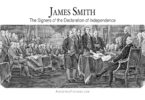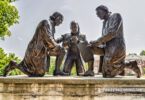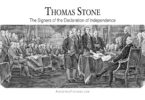William Floyd was born in 1734 in Brookhaven, New York, which is a province of the colony (and later, state) that is located on Long Island. His family was of English and Welsh background. The son of Nicholl Floyd and Tabitha Smith, William was one of several siblings. Most of those siblings either married famous military men from the American Revolution or became well-known military or political men themselves.
A great-grandfather of William and his siblings on their paternal side was Richard Floyd, who was born in Wales and became the last one of his brothers to leave their homeland for America. Richard went first to Jamestown in Virginia, then moved up to New York, where he established himself as a lawyer. Richard’s son bought 4,400 acres of land in Brookhaven, and Richard’s grandson (William’s father) built a house there, where William was later born.
William’s father died when William was only twenty-one years old. William took over the management of the family farm after that and found time to also become a member of the Suffolk County militia at the beginning of the American Revolution. In this position, he was appointed to the rank of Major General. Taking a break from his military duties, he was appointed as a delegate from New York to the Continental Congress from 1774 to 1776. It was during this appointment that he became a signer of the Declaration of Independence. Later, he became a member of the New York State Senate from 1777 to 1788.
William continued his illustrious political career when, in 1787, he was elected as an Honorary Member of the New York Society of the Cincinnati. In 1789, he was elected to the very first United States Congress as a member under the new Constitution, which had replaced the previous Articles of Confederation. In his new position in Congress, William served as an Anti-Administration politician. He remained in Congress until 1791. The following year, he was chosen as a presidential elector for the Electoral College, where he cast his votes for George Washington and George Clinton.
After this, he became a resident of Oneida County, New York. The town of Floyd, New York, is named after him.
William was interested in continuing with his political career after his stint in Congress. He ran for Lieutenant Governor of New York with Gubernatorial candidate Robert Yates on the Democratic-Republican ticket in 1795. This was the party that was founded by Thomas Jefferson. William and Robert were defeated by the Federalist candidates, John Jay and Stephen Ven Rensselaer.
William was back in his presidential elector position with the Electoral College for the 1800 presidential election, where he cast his votes for Thomas Jefferson and Aaron Burr. In the 1804 election, he was still an elector and cast his votes for Thomas Jefferson and George Clinton. After this, he was elected to the state senate of New York in 1808.
William was in demand as a presidential elector and was appointed as one again in 1820, but he did not go to the electors’ meeting. Martin Van Buren was appointed to replace him.
As for his personal life, William married Hannah Jones in 1769. She was born in Southampton, New York, the daughter of William Jones. She and William had three children together, all of whom lived past childhood and got married when they grew up.
However, Hannah died in 1781, and William remarried Joanna Strong a few years later. Joanna was the daughter of Benajah Strong and Martha Mills. William and Joanna had two children together, both of whom lived past childhood and got married when they grew up.
William died in 1821 at the age of 86 and was buried at the Westernville Cemetery in Oneida County, New York. His widow, Joanna, died in 1826. Their family home, called the William Floyd House, is open to visitors in today’s modern times. It is located in Mastic Beach, New York, and is a part of the Fire Island National Seashore. The part of the property that is open to visitors consists of the house, the grounds, and the Floyd family cemetery that is located there. Astoundingly, the house is still owned and managed by the Floyd family today, in an unbroken chain of eight generations and two centuries of Floyd owners. While the estate is much smaller now than it was before the twentieth century, the fact that it still exists and is still owned by the Floyd family is remarkable, as most historic homes are owned by trusts and historical societies after having been sold by the descendants of the original famous owners long ago.
William Floyd has some famous and semi-famous descendants. Via his son Nicholl, he was the grandfather of a US Representative named John Gelston Floyd. Via his daughter Catherine, he was the grandfather of Harriet Ashton Crosby and the great-grandfather of New York State Senator Clarkson Floyd Crosby. Clarkson married Angelica Schuyler, who was the daughter of the famous John Schuyler.
William is remembered in other ways in New York, as one of its famous Revolutionary sons. The William Floyd School District in Brookhaven Town is named after him, and it includes an elementary, middle, and high school that all use his name. There is a William Floyd Parkway in Brookhaven, as well. There is a General William Floyd Elementary School in the Holland Patent School District in Oneida County, New York. There is also a Floyd Memorial Library in Greenport, Suffolk County, New York.
Learn More:




